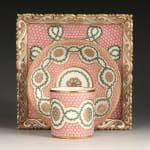Sèvres Porcelain
H.2 3/8 W.5 7/8 D.5 7/8 in
Literature
With the factory marks in blue.
Sets of trays with cups and saucers and more pieces forming a tea set made at the Sèvres factory in the 18th century were named after the model of tray. This tray being a plateau carré therefore makes this set a déjeuner carré and has a matching gobelet Litron et soucoupe of the 3rd size.
Madame de Pompadour had clearly liked this style of tea set as she purchased at least 14 examples in 1762 alone.
This style of ground colour pattern is known as fond Taillandier . It may have been devised by the painter Vincent Taillandier in the 1760s and was probably frequently applied by him, and, from 1774, his wife Geneviève.
It is more usually seen with a pale blue tone, but intriguing variants have been noted including yellow, mauve and fairly-often in green. It is often adapted as an all-over pattern with the remainder of the decoration fitting closely into areas reserved in white.
Fond Taillandier is found from the late 1760s and was much used, notably, around 1770, on a small number of dinner and dessert services such as Lord Melbourne's service today at Firle Place, Sussex. In that service the larger pieces have figural decoration in reserves but the main feature consists of laurel garlands which spatially articulate the objects. The compotiers rond of the Melbourne service have the garlands with nothing else (see image in article), while on our déjeuner there are gilt rosettes.



